J. Williams Beal | |
|---|---|
 | |
| Born | May 19, 1855 |
| Died | July 7, 1919 (aged 64) |
| Alma mater | Massachusetts Institute of Technology |
| Occupation | Architect |
John Williams Beal (May 9, 1855 - July 7, 1919) was an architect in Boston, Massachusetts. [1]
J. Williams Beal | |
|---|---|
 | |
| Born | May 19, 1855 |
| Died | July 7, 1919 (aged 64) |
| Alma mater | Massachusetts Institute of Technology |
| Occupation | Architect |
John Williams Beal (May 9, 1855 - July 7, 1919) was an architect in Boston, Massachusetts. [1]
He was born on 19 May 1855 in Scituate, Massachusetts, to John Beal and Lucy Ann Beal.
He married Mary Washburn.
He trained at Massachusetts Institute of Technology and then worked for McKim, Mead & White before opening his own business. [2] His sons, John and Horatio Beal founded J. Williams Beal, Sons, which designed the Masonic Temple (Quincy, Massachusetts) in 1926, and other area buildings.
He died on 7 July 1919 in Hanover, Massachusetts.

Ralph Adams Cram was a prolific and influential American architect of collegiate and ecclesiastical buildings, often in the Gothic Revival style. Cram & Ferguson and Cram, Goodhue & Ferguson are partnerships in which he worked. Cram was a fellow of the American Institute of Architects.

Washington Street is a street originating in downtown Boston, Massachusetts, which extends southwestward to the Massachusetts–Rhode Island state line. The majority of its length outside of the city was built as the Norfolk and Bristol Turnpike in the early 19th century. It is the longest street in Boston and remains one of the longest streets in the Commonwealth of Massachusetts. Due to various municipal annexations with the city of Boston, the name Washington Street now exists six or more times within the jurisdiction(s) of the City of Boston.

Nathaniel Jeremiah Bradlee was a Boston architect and a partner in the firm of Bradlee, Winslow & Wetherell.
Beacon Street is a major east-west street in Boston, Massachusetts, and its western suburbs of Brookline and Newton. It passes through many of Boston's central and western neighborhoods, including Beacon Hill, Back Bay, Fenway–Kenmore, the Boston University campus, Brighton, and Chestnut Hill.

Cram and Ferguson Architects is an architecture firm based in Concord, Massachusetts. The company was founded as a partnership in 1889 by the "preeminent American Ecclesiastical Gothicist" Ralph Adams Cram and Charles Francis Wentworth. In 1890 they were joined by Bertram Goodhue, who was made a partner in 1895.

Charles Street African Methodist Episcopal Church is an historic African Methodist Episcopal Church at 551 Warren Street in Boston, Massachusetts. The current church building was built in 1888 by J. Williams Beal and added to the National Register of Historic Places in 1983.
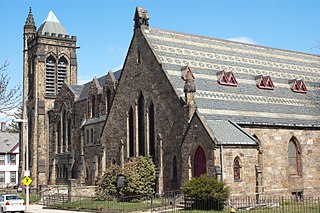
The Eliot Congregational Church is a historic Congregational church at 56 Dale Street, at the corner of Walnut Avenue in the Roxbury neighborhood of Boston, Massachusetts.

First Parish Church in Plymouth is a historic Unitarian Universalist church at the base of Burial Hill on the town square off Leyden Street in Plymouth, Massachusetts. The congregation was founded in 1620 by the Pilgrims in Plymouth. The current building was constructed in 1899.
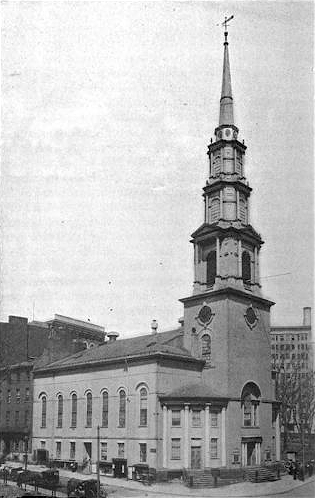
Peter Banner was an English-born architect and builder who designed the Park Street Church in Boston, Massachusetts, and other buildings in New England in the early 19th century.

Hartwell and Richardson was a Boston, Massachusetts architectural firm established in 1881, by Henry Walker Hartwell (1833–1919) and William Cummings Richardson (1854–1935). The firm contributed significantly to the current building stock and architecture of the greater Boston area. Many of its buildings are listed on the National Register of Historic Places.

Allen & Collens was an American architectural firm based in Boston. It was initially established by architect Francis R. Allen in 1879. After two early partnerships he formed Allen & Collens in 1903 with Charles Collens. The firm was best known as the designers of Gothic Revival buildings, including the Union Theological Seminary campus and Riverside Church in New York City. Allen and Collens died in 1931 and 1956, respectively, and the firm was continued by Collens' partner, Harold Buckley Willis, until his own death in 1962.

Kilham & Hopkins was an architectural firm in Boston, Massachusetts formed in 1899 or 1900 by its founding members, Walter Harrington Kilham and James Cleveland Hopkins. The firm later became Kilham, Hopkins & Greeley after William Roger Greeley joined the firm in 1916, and Kilham Hopkins Greeley and Brodie after Walter S. (Steve) Brodie joined the firm in 1945.

Richard Bond (1798–1861) was an early American architect who practiced primarily in Boston, Massachusetts.
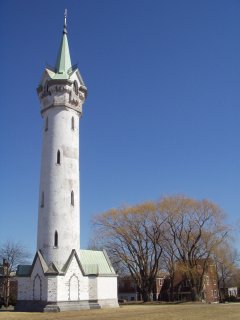
Fort Hill is a 0.4 square mile neighborhood and historic district of Roxbury, in Boston, Massachusetts. The approximate boundaries of Fort Hill are Malcolm X Boulevard on the north, Washington Street on the southeast, and Columbus Avenue on the southwest.

Isaac Melvin (1811-1853) was an American architect from Massachusetts.
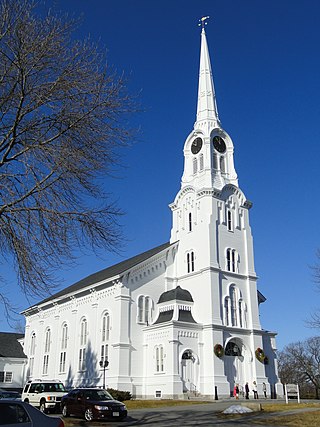
John Stevens (1824-1881) was an American architect who practiced in Boston, Massachusetts. He was known for ecclesiastical design, and designed churches and other buildings across New England.
Patrick O'Beirne was an Irish-born priest who ministered in the Archdiocese of Boston.

The Old Colony Street Railway Company was a horse-drawn and electric streetcar railroad operated on the streets of Boston, Massachusetts and communities south of the city. Founded in 1881 as the Brockton Street Railway Company, via lease and merger it became a primary mass transit provider for southeastern Massachusetts and Rhode Island. Its immediate successor was the Bay State Street Railway, and its modern successor is the state-run Massachusetts Bay Transportation Authority (MBTA).
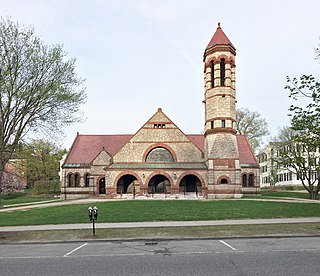
John Lyman Faxon (1851–1918) was an American architect practicing in Boston, Massachusetts, during the late nineteenth and early twentieth centuries. Three of his buildings, the First Baptist Church of Newton (1888), the First Congregational Church of Detroit (1889–91) and the former East Boston High School (1898–1901), have been listed on the United States National Register of Historic Places.

Edwin J. Lewis Jr. was an American architect who designed numerous residential houses and churches in New England.